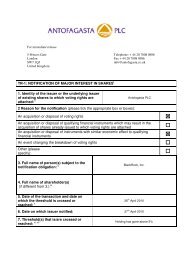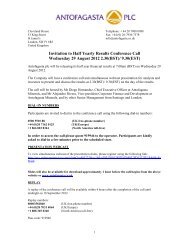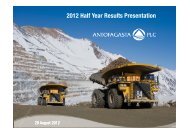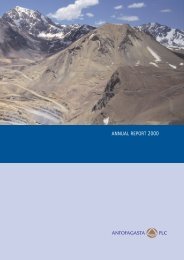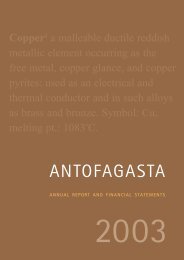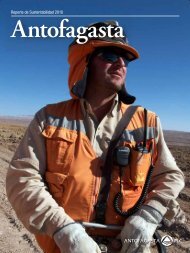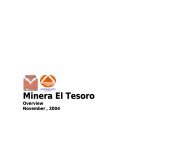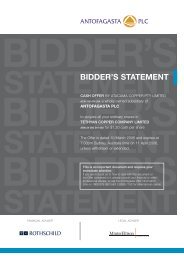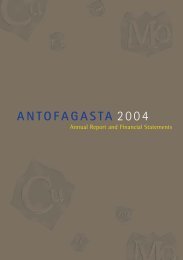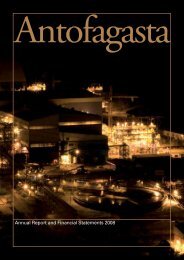Sustainability Report - Antofagasta PLC
Sustainability Report - Antofagasta PLC
Sustainability Report - Antofagasta PLC
Create successful ePaper yourself
Turn your PDF publications into a flip-book with our unique Google optimized e-Paper software.
Water sources are scarce in the <strong>Antofagasta</strong> Region and demand is growing<br />
steady with increased local mining investment. Aguas de <strong>Antofagasta</strong>’s<br />
main environmental challenge is to ensure a continuous and long-term<br />
supply of water. The company has pioneered the use of desalination and we<br />
continue to explore this option to reduce pressure on the scarce natural<br />
water sources located in the mountains, protecting the region’s fragile water<br />
system. Reducing water losses during distribution is central to our<br />
commitment to use resources efficiently and deliver a constant supply of<br />
water to customers. We achieve this by constantly updating and improving<br />
our distribution infrastructure. For instance, in 2011 we introduced a new<br />
technology for monitoring and reducing water leaks. See box.<br />
Environmental management<br />
In February 2011, we achieved ISO 22000 certification for water safety at<br />
Taltal. The standard is designed to improve water safety management through<br />
the supply chain, and we began to implement the standard at our filtering<br />
plants at Salar del Carmen and Cerro Topater, as well as our desalination plant<br />
at La Chimba throughout 2011. Our objective for 2012 is for all our facilities to<br />
gain certification to this standard. If successful, Aguas de <strong>Antofagasta</strong> would<br />
be the only water and sewage utility in Latin America to have achieved full ISO<br />
22000 accreditation.<br />
All our wastewater treatment and distribution operations are certified to ISO<br />
14001. We have also achieved certification for wastewater collection facilities<br />
in Taltal, Mejillones, Tocopilla and Calama and are working to certify<br />
<strong>Antofagasta</strong> City in 2013.<br />
Our environmental team tests and monitors our systems to make sure they<br />
can cope in the event of a natural disaster. See page 80.<br />
We had one environmental incident in March 2011. An unprecedented rise in<br />
Aguas de <strong>Antofagasta</strong> 81<br />
sea temperature resulted in an algae bloom, causing desalinated potable water to<br />
have an unpleasant odour. Water remained safe for human consumption but the<br />
company decided to stop supplying water from the desalination plant until the<br />
problem was solved four days later. We regret any inconvenience caused to<br />
customers and we ensured that those affected were supplied with drinking water<br />
from alternative sources. The company has been fined following the incident and<br />
we are now in the process of appealing against the fine.<br />
To prevent this happening again, we added a new step to the desalination<br />
process so that drinking water is aired, helping to control the smell. The<br />
company also shared information with the scientific community and others in<br />
the desalination industry to help them deal with this problem.<br />
We adjusted our procedures for handling hazardous waste to comply with new<br />
regulations that came into effect in April 2011. Through our waste separation<br />
and recycling programmes, in 2011 we recycled 2 tons of paper and<br />
cardboard, half a ton of plastic, 30kg of tin and 78kg, of printing toners and we<br />
produced 53kg of compost used to fertilise the site’s botanical garden.<br />
Energy and climate change<br />
Aguas de <strong>Antofagasta</strong> aims to improve energy efficiency and reduce use of<br />
fuel and electricity. Desalinating sea water is the most energy-intensive part of<br />
our operations. Our electricity consumption increased to just over 5,000 MWh<br />
in 2011, a 12% increase compared with 2010.<br />
In 2011 fuel consumption was reduced by 8.3%, mainly because old vehicles<br />
in the company’s fleet were replaced with newer and more efficient vehicles.<br />
We report our emissions through the Carbon Disclosure Project and monitor<br />
the carbon dioxide emissions of our administrative services as well as our<br />
operations.<br />
Overview<br />
<strong>Sustainability</strong> at <strong>Antofagasta</strong> <strong>Antofagasta</strong> Minerals <strong>Antofagasta</strong> Railway Company Aguas de <strong>Antofagasta</strong> Appendices



